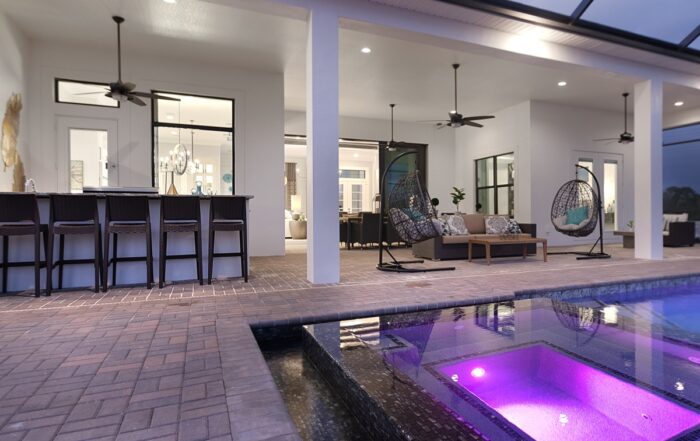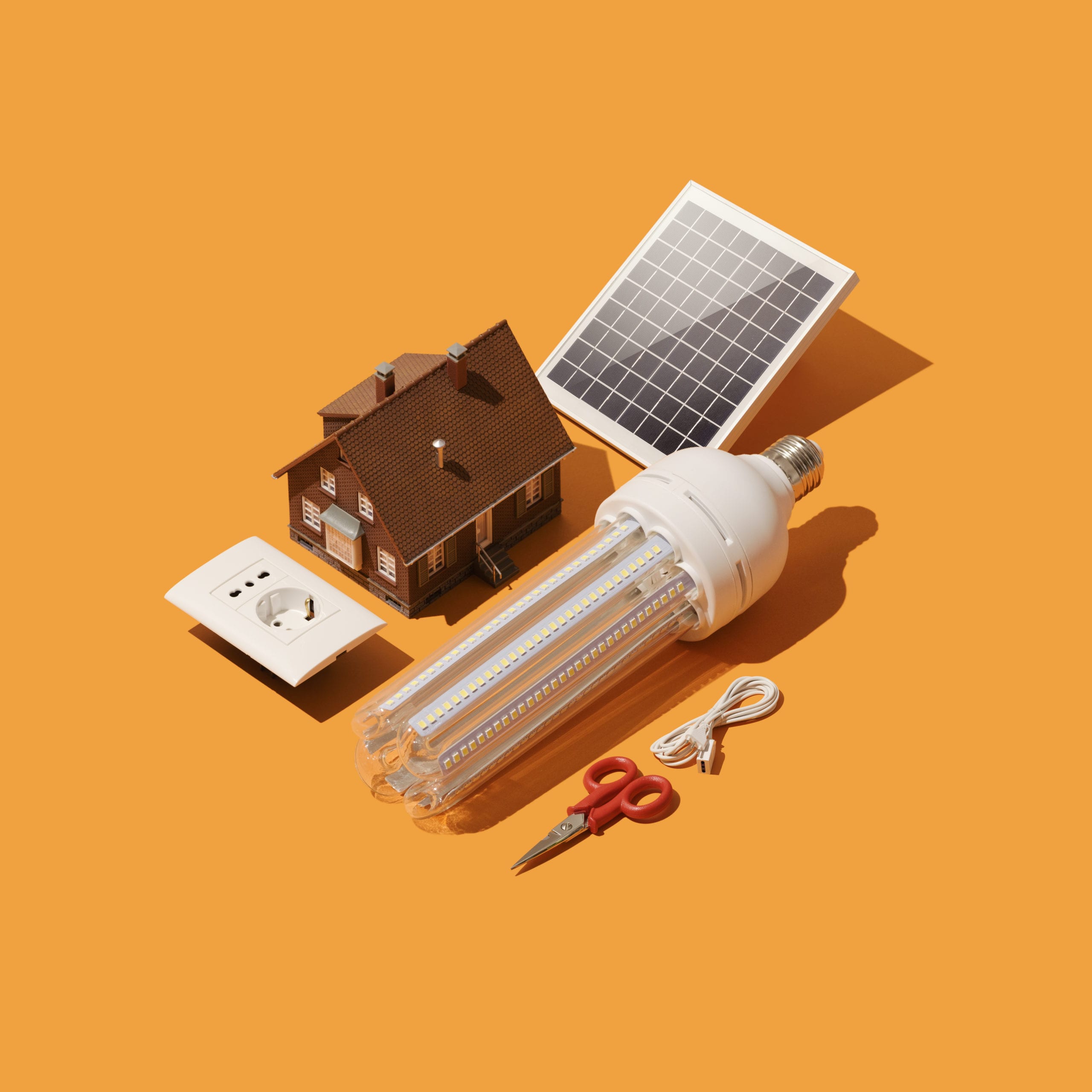
Since 2000, the U.S. economy has grown by over 30%, yet our energy consumption has stayed exactly the same. According to the NRDC, this is due to the recent focus on energy efficiency.
Even more impressively, the energy-efficiency movement has created 30 times more jobs than coal and 10 times more than the oil and gas industries in that timeframe.
With fears about climate change mounting, energy efficiency has come to the forefront of research in homebuilding, car manufacturing, and even consumer electronics.
Solar power has been a buzzword for even longer than energy efficiency, but up until recently, the options were slim, ineffective, and expensive. Today, solar is everywhere, even on top of some new cars.
Even though solar tech is more widespread, it still remains a confusing topic – especially when it comes to implementation in your home.
This post will tackle both topics: how energy efficiency can make a difference, and how solar can be integrated intelligently into your current home and in the home-building process.
Let’s start with the basics.
What is Energy Efficiency and Why is it Important?
There’s no question that energy efficiency is getting a lot of attention these days, but attention doesn’t always mean that something is important.
Energy efficiency has actual legs to stand on. The average household that implemented energy-efficiency methods saved 16% on energy in 2017 while businesses across the US saved over $23B. Energy efficiency has the potential to save you even more money as a movement has grown up around net-zero energy homes. A net-zero energy home would save the average homeowner $2,400 a year.
With energy production and consumption cited as the largest producer of greenhouse gasses, energy-efficiency plays a critical role in stemming global climate change. In fact, an international council has been created to tackle efficient energy production and consumption alone.
Ok, so energy efficiency seems to be a big deal, but what does it mean?
Energy efficiency often gets mixed up with energy conservation. The two are not interchangeable, but understanding both helps you see the differences.
Energy conservation means reducing the number of things you use energy for on a day-to-day basis. This would include things like washing dishes by hand instead of using a dishwasher. 
Energy efficiency is, in many ways, a much easier strategy to implement. Instead of removing the use of a dishwasher completely, energy efficiency would just say to use a more efficient dishwasher. If your dishwasher is from the ’80s and sounds like a tractor-trailer, there’s a good chance it isn’t very energy efficient.
Are you already working on creating an energy-efficient home?
The Benefits of Creating an Energy Efficient Home
The greatest benefit of energy efficiency compared to energy conservation is that you don’t have to change your daily habits. No need to compost your waste, only flush your toilet once a day, or take cold showers. You can still enjoy all the benefits of modern technology without the guilt of spending money on energy and creating pollution.
According to Energy Sage, the average home can easily cut out 25% of monthly energy costs with just a few small improvements. That’s an average home savings of $550 a year.
Energy efficiency also greatly reduces water usage which has become a recent and growing concern in states like California.
Energy-Efficient Changes You Can Make Today in Your Existing Home
The overall topic of energy efficiency can be a bit daunting when viewed in its entirety, but it doesn’t have to be. Small changes can drastically improve your energy consumption without changing your lifestyle.
Changing Out Lightbulbs
We’ve all been told since we were children to turn off the light after we leave a room. Turns out, you don’t have to turn them off anymore.
LED lights can save you up to $2k over the life of the bulbs. To put this in perspective, if you were to run LED lights nonstop for 10 years throughout your entire house, you would still spend less than normal usage with traditional bulbs. 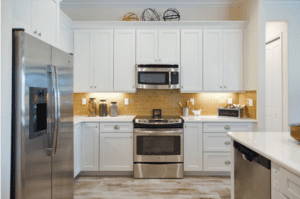
Lightbulbs are one of the easiest ways to introduce energy efficiency to your home. At a cost of roughly $4 a bulb, most people can completely outfit their house with LEDs for under $200 – a cost that will pay for itself within the very first year of use.
Many modern lightbulbs are “smart” as well as efficient. Smart bulbs can be turned on and off from your phone from anywhere in the world. Forgot to turn off your lights as you rushed out the door for work? No worries, just pull out your phone and turn them off when you reach the office.
Smart bulbs run closer to $8 a bulb, so the savings might be negligible in the first two years, but the added functionality is worth it for those who value the connectedness that they offer.
Adding Seals and Weather Strips
Weatherstrips and sealant is an afternoon task that pays you back immediately. According to Construction Magnet, your home loses heat and cooling power through many different avenues: 35% through your walls, 25% through windows, 15% from your floor.
By sealing off gaps between walls and windows, or adding weather strips to your doors you can save between 10-20% on heating and cooling. This is almost equivalent to buying a brand new energy-efficient AC unit for the cost of a bit of foam sealant and weather stripping which can be as cheap as $8.
Replacing AC Filters
We’re all guilty of forgetting to change out our AC filter, but the benefits of staying on top of replacement are anything but forgettable.
Apart from the intangible aspects of air filters such as a reduction in allergens and air pollutants, and an increase in the lifetime of your AC unit, replacement can have an impact on your wallet as well.
Air filter replacement decreases AC energy consumption by 15%. Since your AC is responsible for roughly half of overall energy use, that equates to 7.5% less energy usage every month, or $11.50 saved on the average energy bill.
Other Quick Hacks to Increase Energy Efficiency
This is by no means an exhaustive list of ways to quickly increase energy efficiency. That’s why we wrote one for you. For more ways to upgrade your home, check out ENERGY HACKS TO REDUCE YOUR ELECTRIC BILLS
What is Solar Power and is it Worthwhile?
You have likely heard of solar power for years. When it was originally introduced to the public in the ‘70’s it was heralded as the answer to energy concerns. No more would there be any fuel crisis, solar would fix all of those problems.
Looking backwards, it’s clear to see that solar hasn’t quite become the mainstay it was expected to be. One of the biggest factors behind this was cost. Up until the ’90s, it cost between $20 to $100 for a single Watt an hour generator.
Putting that in perspective, the average household uses 7,575 Watts a day. You would need to purchase 315 generators to put out that kind of energy, or between $6,312 to $31,562 in cost for the generator alone before factoring in installation. Add to that the unreliability of the technology of the time and it’s easy to see why solar didn’t take hold of the market like it was expected to. 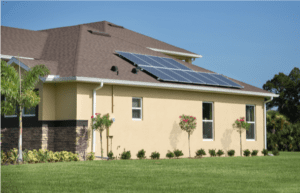
Today, however, solar has become much more viable. The cost per Watt generator has dropped from the $100 figure down to between $2 – $4. With reliability increasing tenfold with new technology, solar is finally becoming a good option to decrease energy spending and greenhouse gas production for consumers.
While most houses don’t opt for a complete solar setup that would effectively replace energy consumption from a power plant, many homes are implementing energy conservation systems.
At LifeStyle Homes, we’ve implemented a two-part solar system. We both install solar panels, and build the home with energy efficiency in mind. In this case, the full system is greater than the sum of its parts.
By having an energy-efficient home from the start, you actually need fewer solar panels. When you need fewer solar panels, you have a lower cost and more solar efficiency.
In consumer applications of solar power, this should always be the goal. Installing solar panels on a home that isn’t already optimized can only help so much. Oftentimes, installing those solar panels won’t even reduce energy consumption as much as simple energy-efficiency improvements.
Using both systems in conjunction can create incredible results. In 2010 LifeStyle Homes built the first zero-energy home on Florida’s East Coast. Since then, we’ve recreated that performance through our dual-prong approach of solar power and energy efficiency hundreds of times.
What to Look for When Buying a Home
New homes often are built with energy efficiency in mind. As the topic becomes a growing concern for buyers, builders, and the government, energy efficiency has become a building block of home design.
Without having an energy-efficient approach in the building process, the ability to have a low energy home without major improvements is much more difficult.
At LifeStyle Homes, we’ve integrated what we call our SunSmart system. This is a process of building with energy efficiency in mind.
Before we ever install solar, we lay out our building plans with energy-efficient steps. Whether you buy a LifeStyle home or elsewhere, there are a few aspects you should be looking at when purchasing a new home.
What Water Heater is Installed?
Water heaters are the second-largest drain on energy after the air conditioner. When buying a used home, you are likely to notice that the water pump is more than a couple of years old and not energy-efficient, to say the least.
The simple truth is that many homes just aren’t built with energy efficiency in mind. A quick way to get a litmus test of the overall focus on energy efficiency in a home is to look at the water pump. 
If it’s Energy Star rated, that’s a great start. If the water heater is a “heat pump,” then you know you’re getting a home with energy-efficiency at its core.
So what is a heat pump? Heat pumps work much like a refrigerator. Instead of creating heat directly, they pull heat from the air. Heat pumps are 2-3 times more efficient than a traditional water heater.
Their only drawback is that they don’t work if the outside temperature drops below 40 degrees. In places like Florida where we at LifeStyle build our homes, this isn’t much of an issue. However, if you’re in a colder climate make sure you understand a heat pump’s limitations before buying one.
Have the Air Ducts been Pressure-Tested?
One issue that is often overlooked in the creation of an energy-efficient home are the air ducts. Older ducts, and even newer ducts with faults in them, often blast cold air into the attic through gaps in the material.
If a gap is large enough, this can drastically increase the cost of running your air-conditioner or heat as you’re pumping air into a huge un-insulated area.
The cost of pressure testing your AC is low, and often extremely worthwhile in older homes as the likelihood of gaps is higher. Our new homes are pressure tested as part of our SunSmart system. If you’d like to learn more about pressure-testing, check out this article by the experts over at Retrotec on the value of pressure-testing.
Is the Insulation Actually Energy Efficient?
We all know how important insulation is to keeping your home energy efficient, but its effectiveness can hardly be overstated. Inefficient insulation can cost you 20-30% more than efficient alternatives. When we’re talking about the efficiency of your air conditioner, the number one culprit of energy consumption every month, those numbers are huge.

Source: energystar.gov
Insulation requirements are different for each state given the environmental demands placed on a home. Insulation is measured with what is called an R-Value. These R-Values represent how strong insulation is at being a heat barrier.
It’s important to know what R-Values you need to hit depending on where you’re buying a home. If you’re in Maine, you are going to need some high R-Values. However, in Florida or Texas, your needs are much lower. Typically, you’d like to see an R-Value that is higher than the general recommendations when your goal is energy efficiency.
There are two ways to look at the R-Value of insulation: the value of the material and overall value of the insulation.
Every type of insulation has a different R-Value per inch of insulation. For example, plywood has an R-Value of 1.25 per inch while polystyrene insulation has an R-Value of between 6 and 7.
The second way to measure R-Value is the overall number. Let’s say that your home has 2 inches of plywood and 3 inches of polystyrene. If you add up the total R-Values, your overall R-Value is 23.5.
Homebuilders will often have the insulation R-Values listed on their home-specs, so it’s worthwhile to know your values before buying a house.
How Efficient is that Air Conditioner?
Air conditioner efficiency is more nuanced than you might think. The efficiency of the machine straight from the box is important, but that’s not all that goes into its effectiveness.
Starting with an energy star air conditioner is the first thing to look for; the second being a heat pump. Remember the heat pump water heater? The same thing applies to air conditioning.
Instead of creating heat or cold air, the heat pump HVAC can gather heat or remove heat from the air surrounding the unit to keep your home at the right temp without using huge amounts of energy.
After you’re sure you have a good HVAC unit, placement becomes important. Air conditioners were placed in the garage in a lot of older home models. This becomes an issue when you consider that garages are rarely air-conditioned or insulated.
Your air unit now has to focus on two things: creating the desired air temperature and keeping the outside temp out of the unit itself. By creating a space for the AC unit in an air-conditioned space, you can drastically cut down on energy consumption by removing one of the steps.
What Else Should I Look for in a Home?
These recommendations are only the tip of the iceberg. Having an energy efficient home truly requires a holistic approach.
You can also check out some of the other measures we utilize in our SunSmart system to create homes with energy-efficient methods from the ground up.
Are You Ready for Solar?
If you’ve already upgraded your appliances to be energy efficient, checked your air ducts, added insulation, and installed weather strips, it’s time to start looking at solar installation.
Just because your home wasn’t built with solar panels pre-installed doesn’t mean they can’t be retrofitted. There are a few steps to take to prep your home for solar:
1: Audit Your Energy Efficiency.
Using the strategies in this post, check out how efficiently your home is running.
2: Inspect that Roof!
Since solar is installed on top of existing roofs, you want to make sure your roof can handle the added technology.
Since roofing has to be replaced roughly every 10 years, it’s smart to do this before installing solar panels. This keeps you from having to redo the roof and have your solar panels reinstalled which can get expensive quickly. 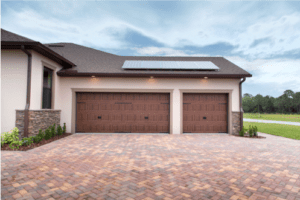
Materials also play a huge role in solar installation. More delicate materials don’t fare well with the weight of solar panels and many solar companies will avoid these installations altogether. If your roof is made of cedar or slate, solar may not be an option for your home. Most other materials will be just fine.
The roof also needs to receive direct sunlight for most of the day to be worthwhile for solar installation. A little bit of shade can be fine, but if you have tree cover over your roof for most hours of the day your solar panels will only be so effective at capturing energy.
For a more complete list of what to look for in a solar-ready roof, check out this in-depth post by energyusage.com.
3: Get a Quote.
Solar systems capable of generating enough power for your entire house can run between $6k and $20k depending on your needs, so it’s a good idea to be prepared to spend that kind of money. One benefit of buying a solar home from LifeStyle Homes is that the upfront cost of solar is rolled into your home purchase and the benefits are available immediately.
Tying it All Together
The importance of energy-efficiency is only growing, and new technology is making it even more attainable. Instead of having to cobble together expensive products to make your home a tiny bit more efficient, there are now so many options to create a holistic approach.
If you’re interested in learning more about LifeStyle SunSmart or solar homes, feel free to reach out!


